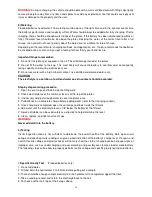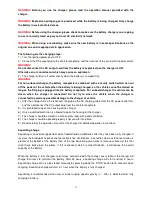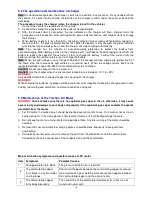
14
WARNING!
During recharging, the vehicle should be parked in a well-ventilated area with filling
caps tightly
secured. Keep far away from any flame and sparks to avoid any explosion or fire that could cause physical
injury or damage to the property and the user.
5) Watering
Flooded batteries need water. The watering must be done at the right time and in the right amount or else
the battery’s performance and longevity suffers. Water should always be added after fully charging. Prior to
charging, there should be enough water to cover the plates. If the battery has been discharged (partially or
fully), the water level should also be above the plates. Keeping the water at the correct level after a full
charge, then you will not have to worry about the water level at a different state of charge.
Depending on the local climate, charging methods, and application, etc., Trojan recommends that batteries
be checked once a month until you get a feeling for how thirsty your batteries are.
Important things to remember:
1
. Do not let the plates get exposed in the air. This will damage (corrode) the plates.
2
. Do not fill the water to the cap. This most likely will cause the battery to overflow acid, consequently
losing capacity and causing a corrosive mess.
3
. Do not use water with a high mineral content. Use distilled or deionized water only.
CAUTION:
The electrolyte is a solution of acid and water so skin contact should be avoided.
Step by step watering procedure:
1. Open the vent caps and look inside the filling wells.
2. Check electrolyte level; the minimum level is at the top of the plates.
3. If necessary add just enough water to cover the plates once.
4. Put batteries on a complete charge before adding water (refer to the Charging section).
5. Once charging is completed, open the vent caps and look inside the fill wells.
6. Add water until the electrolyte level is 1/8" below the bottom of the fill well.
7. A piece of rubber can be used safely as a dipstick to help determine this level.
8. Clean, replace, and tighten all vent caps.
WARNING!
Never add acid into the battery.
6) Testing
Visual inspection alone is not sufficient to determine the overall health of the battery. Both open-circuit
voltage and specific gravity readings can give a good indication of the battery's charge level, life span, and
health. Routine voltage and gravity checks will not only show the state of charge but also help spot signs of
improper care, such as undercharging and over-watering, and possibly even locate a bad or weak battery.
The following steps outline how to properly perform routine voltage and specific gravity testing on batteries.
I. Specific Gravity Test
(Flooded batteries only)
1. Do not add water.
2. Fill and drain the hydrometer 2 to 4 times before pulling out a sample.
3. There should be enough sample electrolyte in the hydrometer to completely support the float.
4. Take a reading, record, and return the electrolyte back to the cell.
5. To check another cell, repeat the 3 steps above.
Summary of Contents for Bubble Buddy
Page 5: ...5 Fig 2 Fig 3...
Page 29: ...29...






























